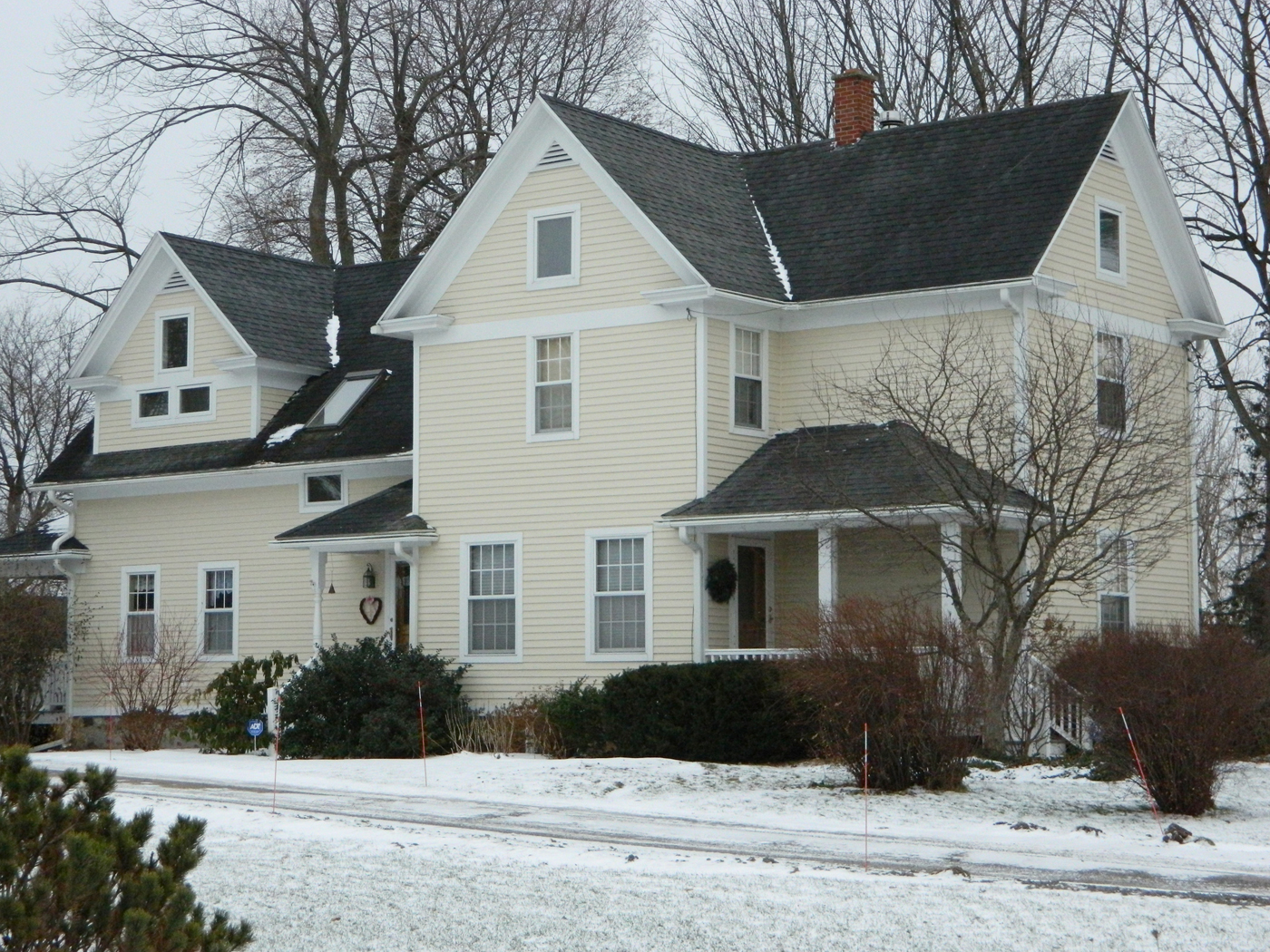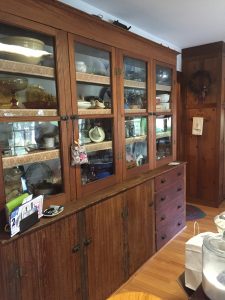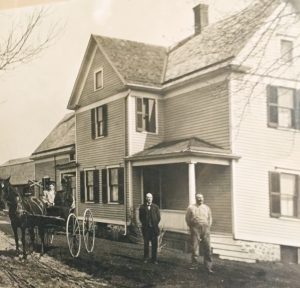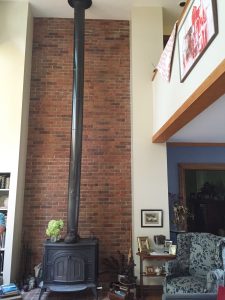Chili historic home awarded landmark status

Chili has added another home to its historic landmark system. The Archer Homestead at 150 Archer Road came to the attention of the Chili Historic Preservation Board this past year. An investigation by board members resulted in the successful inclusion of this historic place, which is more than 100 years old. The following is a report filed by Rona Pearce, lead investigator for this project:
We were greeted by the aroma of zucchini bread still cooling in preparation for our visit. The property has been in the family of Sandra Maloney Foley for three generations. Mrs. Foley’s grandfather, Michael Maloney, purchased the home in 1921.
This stately Victorian home sits on a slight rise from Archer Road. Driving into the driveway, we passed a lovely garden, designed and planted in the shape of New York State for her grandmother by her grandfather.
 Mrs. Foley met us on the back porch and led us into a vestibule with an area that holds the utilities. We entered a central hall with access doors to the kitchen on the left and a powder room on the right. On the south wall of the hallway were 20 to 30 family pictures and a history of 150 Archer. Mrs. Foley and her family moved into the home in 1984.
Mrs. Foley met us on the back porch and led us into a vestibule with an area that holds the utilities. We entered a central hall with access doors to the kitchen on the left and a powder room on the right. On the south wall of the hallway were 20 to 30 family pictures and a history of 150 Archer. Mrs. Foley and her family moved into the home in 1984.
The first impression as we entered the hallway was of the chestnut trim throughout the house, never painted, and lovingly cleaned and treated with wood oil. At the end of the hall were stairs to the second floor. Directly ahead, we entered into the great room created by removing half of the second floor. There was a soaring ceiling, sliding doors to the porch and skylights that wash the floor with light. Near the west wall of the great room sits a very large Franklin stove with the space behind the stove covered in brick and a stove pipe that reaches to the roof top.
On the north side of this expanse is a dining room, and around the corner, a formal entrance to the house. A vestibule leads into the formal dining room. Off the dining room on the front of the house is a small sitting room.
 Some bedrooms on the second floor open to the hallway with a view of the great room below. The rest of the second floor remains with its central hall to bedrooms and a master suite.
Some bedrooms on the second floor open to the hallway with a view of the great room below. The rest of the second floor remains with its central hall to bedrooms and a master suite.
And last, but not in any way least, we headed back downstairs to the kitchen. Martha Stewart could walk in and say, “Oh my, Oh my!” The redesign incorporated much from the original kitchen. The first thing you note is a center island – not a usual island, but one which holds her grandma’s baking table with pull out bins that hold baking supplies. The top is also reclaimed wood, surrounded with glass canisters for sugar and flour, recipe books and modern cookers. All the drawers have original pulls. Especially designed for this kitchen are the shaker-style cupboards, color matched to the chestnut woodwork, blending in perfectly to the 1898 era. Below the cupboard is a breakfast bar with stools.
Directly opposite on the south side of the long hall is the original chestnut wood cupboard, originally eleven feet long, but shortened to eight feet to adapt to the kitchen wall. It has all original hardware and glass doors.
Opposite the island, are her stove and sink with a large window overlooking the deck. On the east side of the rectangular kitchen is another sliding door leading to the deck and numerous cupboards and windows overlooking the yard and barn. Tucked in a corner are a desk and electronic accoutrements, computer and printer files.
 In the center is a large round table and chairs with a view of the side yard, and a large deck constructed in two levels: the top level holds a hot tub and cooking area, and the lower level has wide stairs leading to the back yard, gardens and tables for dining.
In the center is a large round table and chairs with a view of the side yard, and a large deck constructed in two levels: the top level holds a hot tub and cooking area, and the lower level has wide stairs leading to the back yard, gardens and tables for dining.
Town Historian Peter Widener and board member Earl Basset described the basement with mill-cut timbers and mill-cut floor joists. The home exterior is constructed with cedar clap-boards. The interior floors are maple and oak. There is a rubble stone foundation and crawl space. The doors are trimmed with chestnut wood. A blight killed off the American chestnut during and after the Civil War; it is unusual to have an original door in this wood. Hinged entrance doors have center-mounted door chimes indicating a home dated between 1865 and 1890s. There are cut glass door windows at the side of the north entrance. Some interior doors are double-hinged used in the early 1900s. Some of the windows are new and are eight over eight, all in Victorian style.
Peter and Earl describe the barn as a “phenomenal example” of an early Chili barn, measuring approximately 30’ x 100’ with a gambrel roof and racking supports, most likely built before the main house. It has hand hewn beams, complete milking stanchions and stud stalls for the bull. The second floor is quartered with complete box stalls for two horse team draft horses.
There is an herb and flower garden, and fruit trees and vegetables. Around the milk house there is a grove of American Bamboo trees, planted to help keep the milk house cool. There are black walnut and maple trees. The driveway provides plenty of parking for cars and tractors.
Seated on the deck, we viewed the entire property. We saw what really makes a farm – barns, the berry patch, vegetable garden and hardworking people, or in this case, a hard-working owner.
Mrs. Foley had one more surprise for us. She appeared with a little black box with golden trim where one keeps their most important papers. Inside the box were all the property abstracts from the time when the abstract was for 3,000 acres and all the other dated abstracts up to 1984 – a complete historic record of the property.
Sam Archer bought the farm with 72 acres of fertile soil and open fields. The families who have lived here passed down a bit of folk lore about an original two-room cottage on the property with indoor plumbing. It was called “the rabbit house” where children used to play.
Mrs. Foley’s grand and great-grandparent lived in West Chili at Buckbees Corners. Her great grandfather owned the black smith shop, now a part of Genesee Country Museum and called “The Tin Shop.” Their family names were Taylor and Mayer. Sandra’s roots run deep in Chili.
To see photographs and read articles about other Chili Landmarks, access the web at http://townofchili.org and follow the link under “Discover Chili” to “Chili’s History.”
Provided information and photos




